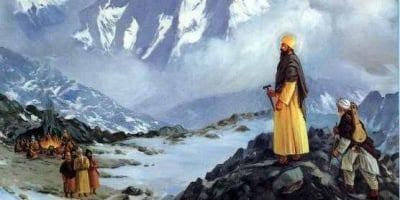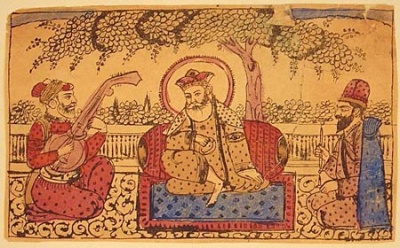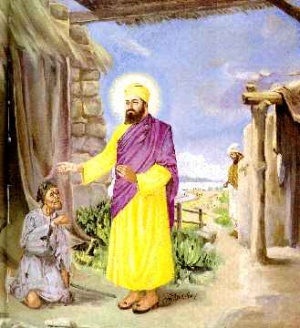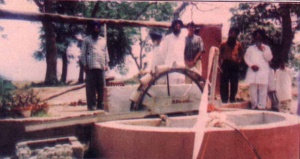Establishment of Kartarpur
PART 1
- Having completed the 4 udasisa (journeys), after a short stay at Lahore, Guru Nanak began his travels once more. This time he directed his steps towards his native village, Talwandi. As usual, he travelled by short stages. He halted at every village on the way, delivering his message to the people, and gained many followers. In due course, he arrived at his destination. His aged parents were glad to meet him. His disciples and admirers assembled to hear him every day. His parents were blessed with spiritual insight. They accepted him as their spiritual guide and saviour.
- Soon Guru Nanak started again on his tour. Travelling in his usual manner, he arrived near the river Ravi. He selected for his stay a beautiful spot on the right bank, not far from Batala. The area was covered in vast number of farms.
- During one of the mid day time, seated there he was blissfully engrossed in singing GOD's Holy Shabads / SatGur from GurBani. Staying nearby, wife of the farm owner Meeto was busy in packing lunch for her husband Karoria (Karori Mal) & other workers, working in fields.
- She was mesmerized by the heavenly kirtan of 'Devine & holy Messages for Humanity descending right from GOD'. So absorbed was she that she just did not realise as to when she completed the job in hand , picked it up, walked her way like a zombie & was face to face with Guru Nanak and Bhai Mardana.
- Having found both lost in singing, She placed the food basket in front of her and sat down on the grass a safe distance from Guru ji and Bhai Mardana so as no to disturb them. Now Meeto was a member of the singing Jatha (team).
In due course, Guru ji stopped the kirtan & found Meeto sitting nearby. "Haa Bhatee, come near, so we can talk", said Guru ji.
Meeto moved forward at presented the food basket to Babaji and said "Baba ji, please accept this."
Guru ji, observing the love in Meeto's eyes, served the food to all three of them as is the tradition in the culture of that time. They all eat the food and exchanged some words.
Meeto asked Guru ji to be excused as she was late meeting her husband, Karoria. She was so excited to tell her husband that she almost ran all the way to the west fields. Upon reaching her husband, she passionately described the scene wonderful "Sadhu" that she had just met. As Meeto was late, Karoria was too hungry to take any notice of what she was saying.
"Why are you so late? You know how hard we have to work! I don't want to hear about any Sadhu. Let's have the food first", he blurted.
She served the food to her husband and the 5 workers. Then she again told Karoria about Guru ji. Now that he was not hungry, he listened and agreed to meet the Guru.
They immediately went to meet Guru Nanak and Mardana. When they met the Guru, Karoria said, "Baba ji all these fields as far as the eye can see belong to me."
Guru ji said, "Karoria, who owned the fields before you".
"Baba ji, my father owned these fields before me", he replied.
"And Karoria, who owned them before your father?" ask Guru ji
Karoria got a bit worried as he got the impression Guru ji may be testing him. So he began to think carefully and answered, "Well, Babaji, my grandfather owned the fields before my father did".
"Karoria Ji, tell me where have they (meaning father and grandfather) gone now?" asked Guru ji.
As Karoria answered "Well Baba ji, they have left this world", it dawned on him that the fields did not really belong to him as he will be gone soon as well.
Karoria having understood the clear message given by Guru ji, touched Guru ji feet in reverence and asked Guru ji to stay with them for a little while.
Guru ji agreed to this request.
PART2
Soon people came to know of Guru Nanak and of his divine message. They were delighted to hear his soul-inspiring songs and discourses. They accepted him as their spiritual guide and became his disciples. The Guru’s fame soon spread in that locality. Hindus and Muslims, of all classes and castes, and sadhus and faqirs, flocked to him. Inspired by his songs and discourses, they gave up their mutual hatred and jealousy, and began to live together like brothers.
Karoria, who was the owner of the area, became annoyed with the daily growing popularity of the Guru. He decided to go and tell the Guru to move away from his land. Mounting his horse, and taking with him a strong party of foot-men, he started on his mission. He had not gone far when his horse stumbled and fell headlong on the ground. He however, suffered no serious injury, but followers took him back home.
He rested for a couple of days, and then set out again, determined to drive away the Guru. He had not yet gone far from the gate of his house, when he felt that he could not see; his eye-sight had gone. The horse came to a halt and refused to move. He got down from the horse and went back home. He was filled with wonder at what had happened. His followers said to him, “He is a holy man, a lover and servant of God. You were going to him with the intention of expelling him. So God did not allow you to proceed.”
“Yes,” said he, “that seems to be the case. I shall go and show him all respect.” Saying this, he mounted his horse again. But as he proceeded, he lost his sight again. He was puzzled all the more. His followers advised him to go on foot. They said, “Make your heart free from pride and anger, and humbly beg his forgiveness before starting.”
Karoria accepted this advice. He humbly prayed that he might be forgiven and started barefoot to meet the Guru. Soon he reached the place where the Guru was. He saw the latter seated calmly, surrounded by a large number of devotees. The sweet music that was being played filled Karoria with indescribable peace.
He fell at the Guru’s feet. His whole being got filled with joy that he had never known before. The Guru affectionately asked him to take a seat near him. A great change took place in his heart. A desire to serve the Guru awoke in him. He bowed, touched the Guru’s feet, and said, 0 true teacher! I am blessed at the sight of you. I feel sure that I have been forgiven. Kindly permit me to dedicate all this land to you. Allow me to build here a village for you and your disciples’ to live in.’ Let us call the village "Nanakpur" in keeping with tradition of the time when the landowners name was used to name the local village.
The Guru smiled and said, “Let it be as you please, but as the land is of Kartar (God the Creator), and you are blessed for dedicating it to divine service. We shall call the village Kartarpur, the seat of Kartar, the Creator.”
Bhai Duni Chand also built a dharamsala and a house for the Guru. Here the Guru stayed for some time. He put off the extraordinary dress which he had put on during his wanderings. He began to wear the usual dress of the people around him.
In a short time, the place grew in importance. Hearing of the Guru’s’ settlement at Kartarpur, people came from far and near to pay their homage. Houses and dbar~nsa1as were built, and the village grew in size, importance and population. His family also moved to the village. Kartarpur became the seat of the Guru. Amid singing of hymns, morning and evening, and discourses by the Guru, the congregation grew larger and larger. The free kitchen fed all who came. In the Guru’s langar (free kitchen) no distinction of caste, creed or sex was observed. All sat and dined together as members of one family.
The Guru started a small farm which he cultivated and ploughed it himself. Of course, his disciples also worked there. He held that the right way to live was to do so by the produce of one’s own labour. He produced not only what was enough for himself and his family, but much more. He gave the surplus to the kitchen.
Guru Nanak himself set the example of leading a simple householder’s life, and realizing the true spirit of religion — devotation to God and the service to fellow-beings, combining simple life with lofty thoughts, free from outer shams and hypocrisies which keep the mind away from truth. By his own example he showed that salvation could be obtained by righteous living even amidst gaiety and laughter.
Gallery
This Sakhi adapted from the book:
Biography of Guru Nanak, Hemkunt Press, ISBN 81-7010-162-X
see also article Kartarpur
External links
* Kartarpur-Ravi - Sikh Inkalab da Sarot - Surjeet Singh Bhatia Tract No. 529










